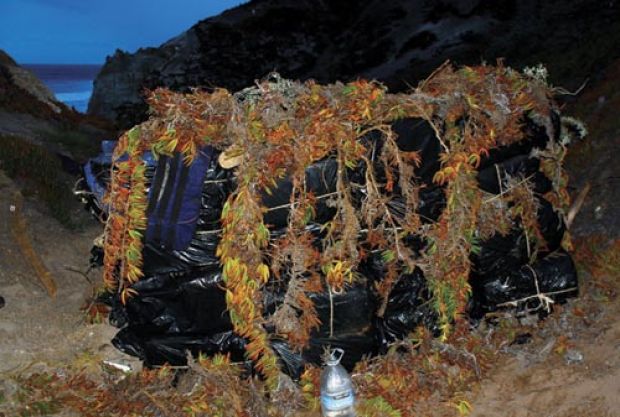Results 1 to 1 of 1
Thread Information
Users Browsing this Thread
There are currently 1 users browsing this thread. (0 members and 1 guests)
-
03-12-2013, 11:44 PM #1
PANGA BOAT LANDING AT VAFB LIKELY ACCIDENTAL
19 hours ago • By Janene Scully / Managing Editor
lompocrecord.com

Smugglers attempted to hide an illegal drug cache from a panga boat north of Vandenberg’s Wall Beach. The collection contained 75 bricks of marijuana, weighing 1,728.2 pounds, with an estimated value of nearly $2.8 million.
Photo by Homeland Security
Officials fighting growing number of incidents along Central Coast
When drug smugglers landed on a beach at Vandenberg Air Force Base it likely was an accidental arrival caused by rough seas or mechanical troubles.
That’s according to Immigration and Customs Enforcement’s Homeland Security Investigations, which is handling the spike in panga boat landings along the California coastline by drug and human smugglers.
Homeland Security Investigations officials said the 20-foot-long aluminum panga boat found overturned north of Vandenberg’s Wall Beach last week was abandoned along with bales of marijuana and six fuel containers.
On Monday, investigators confirmed that the illegal drug cache contained 75 bricks of marijuana, weighing 1,728.2 pounds, with an estimated value of nearly $2.8 million.
“I don’t think it was their intended landing site for a couple of reasons,” said David Wales, assistant special agent in charge for Homeland Security Investigations in Ventura County.
The biggest reason, he said, is that the drug smugglers typically have a ground crew waiting to cart away the contraband. Vandenberg has restricted access, so anyone without identification would have difficulty getting to that remote section of coastline.
Efforts to camouflage the marijuana bales — they were stashed in the ditch and covered in what appears to ice plant and other foliage — also led investigators to suspect the landing location wasn’t planned.
“It’s fairly coordinated most of the time,” Wales said.
Homeland Security officials met with Vandenberg representatives several years ago to warn them about the increasing incidents of maritime smuggling.
But last week’s landing site wasn’t one Homeland Security officials had anticipated smugglers would use, another indication it wasn’t the intended location, according to Wales.
Panga boat landings on a military installation are rare and Los Angeles area representatives recall only an incident, at Seal Beach Naval Weapons Station in Orange County.
Panga boats have been spotted near the Ventura County Naval Base but not actually on military land.
Maritime smuggling into California via the Pacific Ocean has skyrocketed in the past few years.
In fiscal year 2008, some 45 maritime smuggling events were recorded. By 2012, that number spiked to 210.
San Diego County saw the largest number of incidents in 2012 with 123, which included human smuggling and 18 drug smuggling incidents.
Santa Barbara County had 11 events, including six for drug smuggling and four for human smuggling. San Luis Obispo County had two, one of which involved drugs.
Occasionally, smugglers don’t make it to land by the time they are nabbed. Some 43 off-shore events were noted in 2012.
The number of indictments resulting from maritime smuggling cases in Orange, Los Angeles, Ventura, Santa Barbara and San Luis Obispo counties increased tenfold from 2010 to 2012, according to Virginia Kice, spokeswoman for the U.S. Immigration and Customs Enforcement.
In 2010, seven arrests led to seven indictments. By last year, there were 83 arrests including 81 indictments, 14 convictions and eight search warrants.
Those charged include vessel pilots, crew and offload crew.
“In the last three fiscal years, there have been a total of 142 suspects criminally charged in connection with maritime smuggling activity,” Kice said. “To date, those cases have resulted in 51 convictions, with many of the prosecutions still ongoing.”
The ultimate goal of investigations is to identify higher-level operatives in the smuggling operations, officials said.
The phenomenon of maritime smuggling likely stems, in part, from successful enforcement along other smuggling routes into the United States including border crossings, ultralight planes into California, Arizona and Texas, or through underground tunnels, officials said.
“This is just another opportunity for them to introduce the cash crop,” Wales said.
Investigators believe the drug smugglers launch their trips from northern Mexico, head west 75 or 100 miles to the open ocean to avoid
being spotted and then come north several hundred miles. For the most part, these trips occur in skiffs designed for shallow bay fishing.
“It’s absolutely crazy to be out on the boat like that in the open ocean,” Wales said.
Investigators only have anecdotal reports about the smuggling efforts.
“We don’t really know how many boats they end up losing at sea that we never know about,” Wales said.
Due to the fact that smugglers are endangering lives, federal prosecutors add enhancements to the charges to boost penalties in cases involving human smuggling.
With a spike in maritime smuggling of both drugs and humans into the Central Coast, federal investigators say local residents, especially mariners, could play a key role by reporting suspicious activity. Anything suspicious should be reported to local law enforcement officials.
“We’re still trying to get the public as involved as we can by keeping eyes and ears open and letting authorities know about suspicious activity,” Wales said, adding there have been many incidents of public reports regarding panga boat sightings.
“That’s a tremendous help to law enforcement,” he said.
In one case a commercial fisherman’s report led to a successful intervention of smugglers.
“That was fantastic,” he said. “It does make a difference.”
Officials fighting growing number of incidents along Central CoastSupport our FIGHT AGAINST illegal immigration & Amnesty by joining our E-mail Alerts at https://eepurl.com/cktGTn


 LinkBack URL
LinkBack URL About LinkBacks
About LinkBacks




 Reply With Quote
Reply With Quote


Student suspended for using term ‘illegal alien’ in English class
04-16-2024, 01:30 PM in General Discussion